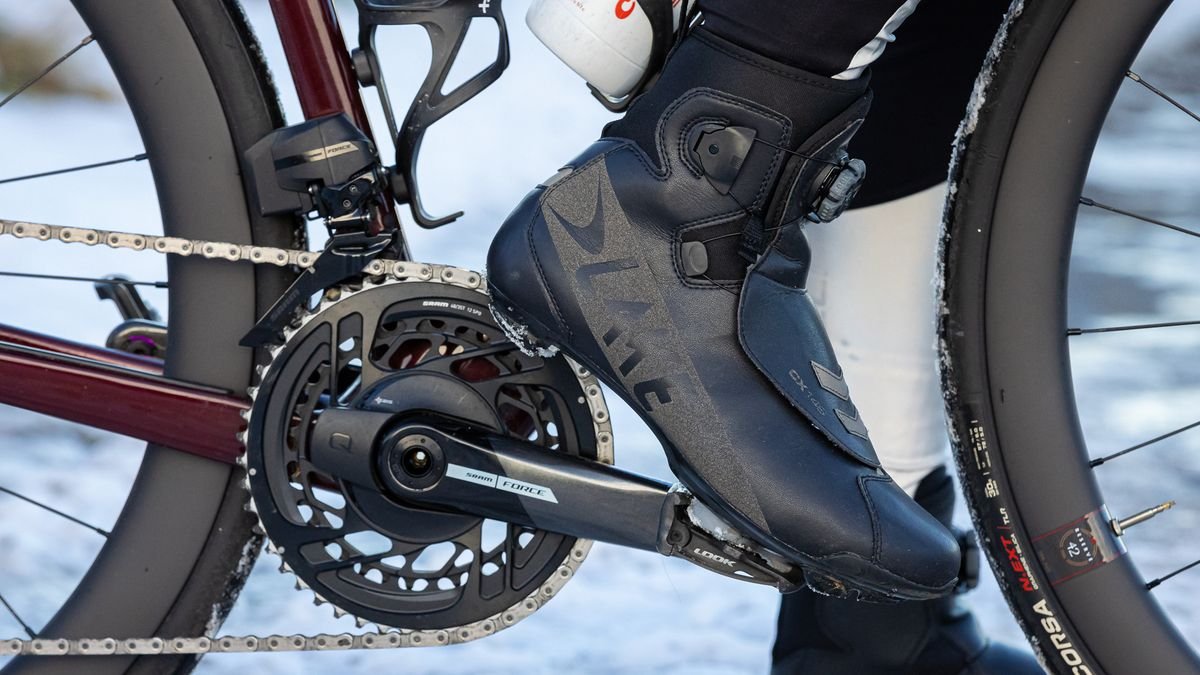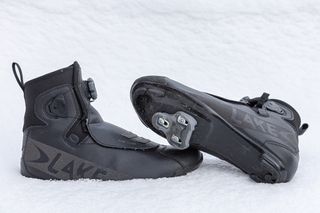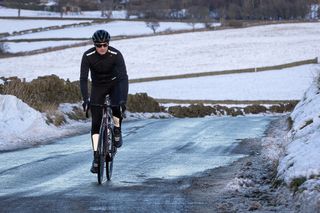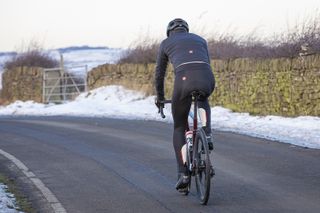
Purchasing a dedicated pair of winter shoes marks a certain point in a cyclist’s life, showing commitment above and beyond the norm to riding in sub-optimal conditions. Whether you are a stalwart commuter or a resolute winter trainer, the move from cycling shoes and overshoes to winter boots puts you in a small subset of riders.
Reasons why you might wish to make the shift include warmth, comfort, quicker to put on and not wanting to get your best summer shoes wet repeatedly. If you do ride a lot in cold, wintery weather then buying a dedicated pair of shoes (boots) makes a lot of sense.
Despite their large cycling shoe range, Lake’s winter footwear offering is pretty simple. Unless you want a very chunky off-road boot or a low-cut winter shoe, then the CX146 is the only choice (2-bolt aficionados can choose the MX146 instead with a grippier sole, but the upper is the same). These replace the CX145 shoes which we gave 4.5 stars to, so the CX146s have some big boots to fill…ahem.
(Image credit: Bob)
Interestingly, Lake’s website says “The CX146 is the answer for those fall or spring chilly road rides. Developed for mild, damp weather, the CX146 is just the right shoe for those days when your race shoes are not warm enough.” To me, this suggests a slight lack of ultimate warmth but a higher level of pedalling performance than most ‘winter’ boots, and ‘mild damp weather’ sounds like pretty much any season in the UK. Officially though, Lake suggests a temperature rating of -4°C, which should cover most sensible riding conditions!
There is a Henry Ford-esque choice when it comes to colour, although you can opt for regular or wide-width fittings, and Lake recommends sizing up 1-1.5 sizes above your normal fit. Full sizes from 36 to 50 are available.
Construction
The upper is made from a water-resistant Clarino microfibre that looks a lot like leather, giving the boots a slightly old-school vibe, backed up by a no-name waterproof membrane. Lake recommends treating the material with a DWR spray to maintain its water resistance and to prevent it from wetting out and impeding breathability. For warmth, there is a thin layer of 200g Thinsulate.
The cuff is taller than most boots, a welcome feature when it comes to road spray, and there is a single BOA M4 dial on the front for closure. This doesn’t offer any on-the-go micro adjustment – the only way to dial it back a bit is to undo it completely by popping it out and retightening it, although its position keeps it a bit safer from crash damage than side-mounted BOAs. The final lace attachment before the BOA is a clip which can be undone completely to aid in putting the boots on or off. The whole of the lace system and tongue is covered by a large Velcro flap which should prevent any water or spray ingress.

Perfect for snowy conditions
(Image credit: Tim Russon)
There is a decent-sized heel tab to aid in pulling the boots on and some large reflective sections on the side and the front for improved visibility in low light.
The outsole is Lake’s Road Sport Fiberglass injected nylon, with a 3-bolt mounting and protective but non-replaceable bumpers front and rear to protect the sole and offer a modicum of grip when off the bike. The insole is worth mentioning too, as it has a deep waffle pattern on the underside to trap air and aid insulation – it’s good to see that this area of high heat loss is protected.
The ride
After taking a measurement or two Lake advised me to go with the regular width size 45s (I’d usually expect to be a 44 in summer cycling shoes from Giro, Specialized, Quoc etc, and I have size 44 winter boots from Northwave).
The boots were easy enough to get on, with the side clip concept allowing them to be opened pretty wide. As with most of these types of shoes, a few moments to make sure that the tongue, tabs and other flaps are in the right place while sat at home is well worthwhile, as it saves any awkward roadside readjustment when you realise that something isn’t quite right.

High cuffs protect from road spray
(Image credit: Bob)
My main concern when first trying the CX146s on was the tall cuff. Not only is it quite high, but it also feels quite stiff and I was worried that it would prove uncomfortable through the pedal stroke. Luckily, it seems that Lake does actually know what it is doing when it comes to shoe design, and it was simply a non-issue; I didn’t notice it at all when on the bike.
On the other hand, I would have preferred a double BOA setup, giving the potential to have different tensions around the ankle and over the instep. The CX146’s predecessor, the CX145, had this feature so I assume that perhaps cost or maybe weatherproofing put paid to it. I found that the best way to get a comfortable tension was to do them up quite tightly, release the BOA and then re-tension them less tightly. This seemed to secure the forefoot and still allow some flexibility around the ankle.

Reflective patches on the heel aid visibility
(Image credit: Bob)
Luckily (?), the boots arrived just as the first snows of winter fell in the Peak District, giving ideal testing conditions. The CX146s felt neat on the bike, not as close-fitting as race shoes of course, but less bulky than some more padded winter boots. Stiffness was fine – again, not race carbon stiff, but plenty stiff enough that there was no sensation of wasted effort.
As I mentioned, the high cuff was not an issue at all in terms of comfort and in fact gave greater protection from road spray. They also mitigated the slight shortfall in leg length of the Castelli Sorpasso RoS Wind bib tights that I was testing at the time, preventing cold, draughty ankles.
I would have liked the heel and toe grips to have been either replaceable or slightly deeper – the main wear area under the big toe has a pretty small rubber lug that doesn’t look like it would offer much longevity. Even in winter, I am frequently off my bike; taking photos, peeing behind trees and even occasionally stopping at cafes, so I do seem to wear out grips more than most.
Value and conclusion
At £200, the CX146s are good value, assuming that you ride frequently in cold conditions; most winter-orientated boots cost more and feel clumsier on the bike. Perhaps the trade-off is ultimate warmth, BOA count and lack of brand name membrane, but none of these things seemed to matter during the test. Furthermore, the high cuff and large reflective patches offer worthwhile points of difference and I liked the classic, leather-like aesthetic too. I also suspect that the CX146s will ‘break in’ nicely over time, further improving comfort and wearability.

